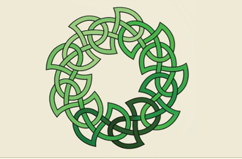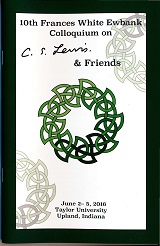Event Title
Paper Session 6-B: Screwtape et. al.: Bad Friends
Location
Euler 108
Start Date
4-6-2016 10:45 AM
Description
"Battlefield of the Mind: Examining Screwtape's Preferred Method" - William O'Flaherty
The Screwtape Letters was initially published in an obscure journal before the book came out in 1942. The impact of what was first a passing thought in the mind of C.S. Lewis led to him gracing the cover of Time magazine years before his Narnia stories became more famous. An overlooked question in the study of the Screwtape Letters is in regard to Screwtape's favorite method for tempting his "patients." The question at hand is, do the devils do their best work by putting things in our minds, or by keeping them out? Screwtape actually boasts that his "best work is done by keeping things out" of a person's mind. While this point is specifically stated in the fourth letter, this approach to temptation is alluded to throughout the book. This talk will reveal Screwtape's most dangerous weapon as it appears in multiple letters, under multiple guises.
"When Friendship Sours: A Study of Trumpkin, Trufflehunter, and Nikabrik" - Vickie Holtz Wodzak
When Caspian wakes up after taking a nasty blow to the head, he finds himself in a hidden, underground home inhabited by two dwarves and a badger, who are debating his fate. Trufflehunter insists on caring for him and flatly rejects Nikabrik's equally earnest insistence that they should never have brought Caspian home and that the only solution now is to bash his head in. This study uses the description Lewis outlines in The Four Loves to evaluate the friendship among the three occupants of the den, examine causes for its failure, and provide a framework for understanding the successful friendship shared by Trumpkin, and Pevensie children, Caspian, and Trufflehunter.
"When Screwtape Haunts in Eden: Testing the Possibilities of the Screwtape-Ransom Speculative Universe" - Brenton Dickieson
I recently had the opportunity to publish an archival piece that reconfigures our understanding of C. S. Lewis's WWII-era fiction project. A previously unpublished handwritten preface to The Screwtape Letters shows that Lewis played with the idea of including Screwtape in the same "other world" as the science fiction books that feature Dr. Elwin Ransom, interplanetary philologist. Using this manuscript evidence, it is important to test the critical limits of an extended Ransom fictional universe--to inquire of the usefulness of including Screwtape's abysmal underworld in the mythic construct of the Field of Arbol. I will suggest a rereading of Perelandra in light of this speculative worldview re-orientation. If a Screwtapian reading of Perelandra confirms the value of considering these books as part of a Ransom Cycle--rather than merely a Space Trilogy--we can imagine the significance for future work in a number of areas including Lewis's invented language and angelology, as well the breadth of his myth-making project.
Event Type
Paper
Paper Session 6-B: Screwtape et. al.: Bad Friends
Euler 108
"Battlefield of the Mind: Examining Screwtape's Preferred Method" - William O'Flaherty
The Screwtape Letters was initially published in an obscure journal before the book came out in 1942. The impact of what was first a passing thought in the mind of C.S. Lewis led to him gracing the cover of Time magazine years before his Narnia stories became more famous. An overlooked question in the study of the Screwtape Letters is in regard to Screwtape's favorite method for tempting his "patients." The question at hand is, do the devils do their best work by putting things in our minds, or by keeping them out? Screwtape actually boasts that his "best work is done by keeping things out" of a person's mind. While this point is specifically stated in the fourth letter, this approach to temptation is alluded to throughout the book. This talk will reveal Screwtape's most dangerous weapon as it appears in multiple letters, under multiple guises.
"When Friendship Sours: A Study of Trumpkin, Trufflehunter, and Nikabrik" - Vickie Holtz Wodzak
When Caspian wakes up after taking a nasty blow to the head, he finds himself in a hidden, underground home inhabited by two dwarves and a badger, who are debating his fate. Trufflehunter insists on caring for him and flatly rejects Nikabrik's equally earnest insistence that they should never have brought Caspian home and that the only solution now is to bash his head in. This study uses the description Lewis outlines in The Four Loves to evaluate the friendship among the three occupants of the den, examine causes for its failure, and provide a framework for understanding the successful friendship shared by Trumpkin, and Pevensie children, Caspian, and Trufflehunter.
"When Screwtape Haunts in Eden: Testing the Possibilities of the Screwtape-Ransom Speculative Universe" - Brenton Dickieson
I recently had the opportunity to publish an archival piece that reconfigures our understanding of C. S. Lewis's WWII-era fiction project. A previously unpublished handwritten preface to The Screwtape Letters shows that Lewis played with the idea of including Screwtape in the same "other world" as the science fiction books that feature Dr. Elwin Ransom, interplanetary philologist. Using this manuscript evidence, it is important to test the critical limits of an extended Ransom fictional universe--to inquire of the usefulness of including Screwtape's abysmal underworld in the mythic construct of the Field of Arbol. I will suggest a rereading of Perelandra in light of this speculative worldview re-orientation. If a Screwtapian reading of Perelandra confirms the value of considering these books as part of a Ransom Cycle--rather than merely a Space Trilogy--we can imagine the significance for future work in a number of areas including Lewis's invented language and angelology, as well the breadth of his myth-making project.


